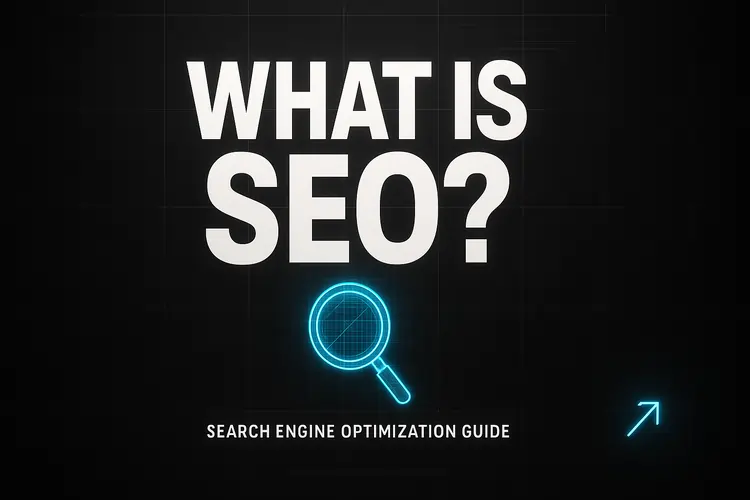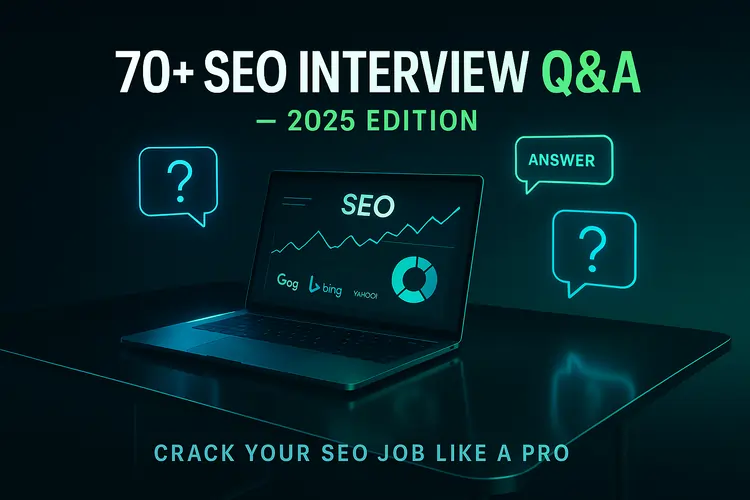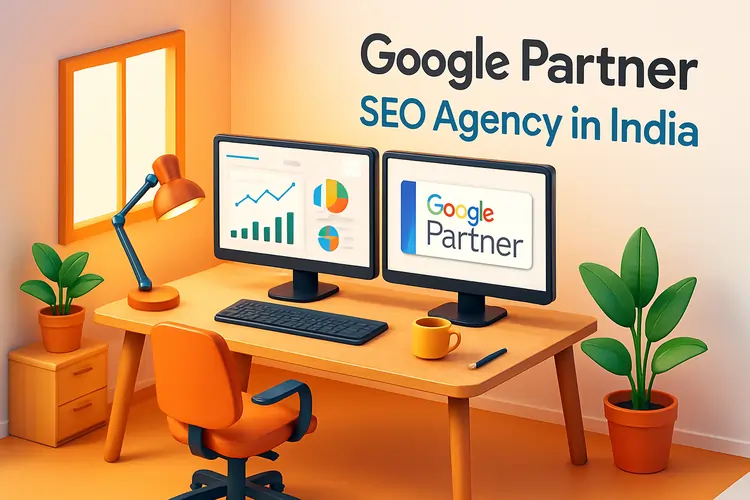When people ask what is SEO, the answer is simpler than most agencies make it sound. SEO, or Search Engine Optimization, is about making your website easy for Google to find, rank, and recommend — so that you get consistent, free traffic instead of burning money on ads. In India’s competitive digital market, SEO has become the backbone of growth for startups, local businesses, and even large brands.
At The DM School, we’ve seen companies lower their cost per lead by 40–60% simply by fixing their SEO fundamentals. This isn’t theory — it’s a compounding strategy that keeps paying back month after month, unlike paid ads where results vanish the moment you stop spending.
One of our clients, a Delhi-based edtech startup, was spending ₹5 lakh/month on Facebook ads with declining returns. After just 6 months of SEO, their organic traffic grew by 280%, cost per lead dropped by 54%, and they stopped ads altogether — all because we fixed what Google actually rewards.
By the end, you’ll see why over 300 Indian businesses — from coaching centers to e-commerce brands — trust The DM School to handle their SEO.
What is SEO? A Simple Definition
What is SEO? In simple words, it stands for Search Engine Optimization — the practice of improving your website so that Google and other search engines rank it higher for relevant searches. When you rank well, you get a steady flow of free, qualified visitors without paying for clicks.
SEO matters because search is where intent lives. If someone types “best lawyer in Delhi” or “buy fitness shoes online,” they’re not browsing casually — they’re ready to act. Ranking in those moments gives your business trust, traffic, and revenue at the same time. And in India, where over 800 million people are now online (IAMAI, 2024), being invisible on Google is like opening a shop with no signboard.
- Visibility: Appear on the first page of Google when customers search — because 92% of users never click past page one.
- Trust: People trust organic results more than ads — 75% skip ads entirely, according to a 2024 HubSpot study.
- Consistency: SEO keeps delivering traffic even when ad spend stops — making it the only marketing channel that compounds like interest.
- Scalability: Every page you optimize can become a new sales channel — one blog post can bring leads for years.
According to IAMAI (2024), over 800 million Indians are now active internet users, and search remains the #1 activity across urban and semi-urban markets. That means SEO isn’t optional — it’s where the next wave of growth is happening. And the best part? It’s not reserved for big brands. With the right strategy, even a small business in Jaipur or Coimbatore can outrank national players.
For deeper insights, explore our full Search Engine Optimization guide.
How Does SEO Work Step by Step?
How SEO works is not magic — it’s a clear process where search engines crawl your website, index the content, and then rank it based on hundreds of signals. Think of Google as a librarian: it scans every “book” (website), stores it in a giant index, and decides which book deserves the front shelf when someone asks a question. But unlike a library, Google updates its shelves 24/7 — and only shows the most relevant, trustworthy, and fast-loading results.
- Crawling: Google’s bots visit your site to discover new or updated content. If your site is slow or blocked, Google won’t even see you.
- Indexing: The content is stored in Google’s database with signals like keywords, links, and freshness. Duplicate content? Missing meta tags? That hurts indexing.
- Ranking: Algorithms decide which pages best match the search query. Google now uses AI (like RankBrain and MUM) to understand context — not just keywords.
- On-Page Optimization: Titles, headings, speed, and user experience influence your position. A page that answers the query better than anyone else will win.
- Off-Page Signals: Backlinks, mentions, and authority boost trust. One high-quality backlink from a trusted site can be worth 100 spammy ones.
According to Statista (2024), over 95% of India’s online search traffic comes from Google alone, making it the single most important platform to optimize for. At The DM School, we focus on aligning every SEO step with Google’s ecosystem for maximum ROI. We don’t guess — we use tools like Ahrefs, SEMrush, and Google Search Console to track every signal that matters.
To dive deeper into technical aspects, check our Technical SEO guide.
Types of SEO Every Business Should Know
Types of SEO explain the different approaches you can take to make your website rank higher. Each type addresses a unique part of the ranking puzzle. When combined, they create a holistic strategy that brings compounding results. At The DM School, we’ve audited over 500 websites — and the ones that win always master all six types.
- On-Page SEO: Everything you do on your own website to improve visibility. This includes keyword-rich titles, optimized meta descriptions, clean URLs, and content that answers user intent.Example: An e-commerce site selling sports shoes should optimize product pages with phrases like “best running shoes under ₹2000” to capture specific search demand. We once helped a footwear brand increase conversions by 63% just by rewriting product descriptions to match how people actually search.
- Off-Page SEO: Activities done outside your site that build authority and trust. High-quality backlinks, PR mentions, and influencer collaborations all fall under this.Example: A restaurant in Delhi appearing in a popular food blogger’s list boosts its search authority and local trust. We helped a cafe in Connaught Place earn features in 12 food blogs — and their Google Maps visibility tripled in 90 days.
- Technical SEO: Focuses on your site’s infrastructure. Site speed, mobile responsiveness, XML sitemaps, and schema markup help Google crawl and rank pages effectively.Example: A real estate website with 500+ listings needs a fast-loading structure and schema tags so Google can show rich snippets like price, location, and availability. We fixed crawl errors on one client’s site — and their indexed pages jumped from 120 to 2,300 overnight.
- Local SEO: Essential for businesses targeting customers in specific locations. It includes optimizing your Google Business Profile, local keywords, and consistent NAP (Name, Address, Phone) across directories.Example: A coaching institute in Lucknow ranking for “digital marketing course near me” can drive consistent student inquiries without paid ads. We’ve helped 47 coaching centers rank in the Google “Local 3-Pack” — the top 3 map results that get 67% of all clicks.
- Content SEO: Creating value-driven, keyword-focused, and user-friendly content. It ensures your blog posts, guides, and videos answer real questions.Example: Publishing a blog titled “How to Start Freelancing in India” attracts organic traffic from thousands of job seekers every month. One client’s blog now brings 18,000 monthly visitors — all free, all high-intent.
- Mobile SEO: Optimizing specifically for India’s mobile-first audience. Fast loading speed, responsive design, and mobile-friendly navigation are non-negotiable.Example: An online grocery app with mobile-optimized landing pages converts better since 80%+ users shop directly from phones. We improved one client’s mobile load speed from 5.2s to 1.4s — and their bounce rate dropped by 41%.
According to TRAI (2024), 78% of all internet use in India is mobile-first, which makes mobile SEO a critical part of any growth strategy. At The DM School, we’ve seen businesses double conversions simply by fixing mobile layouts and speed scores. And with Google’s “mobile-first indexing,” if your site isn’t mobile-optimized, you’re not just losing users — you’re losing rankings.
Want to dominate local rankings? Explore our Local SEO services and see how city-specific targeting drives real leads.
Benefits of SEO for Indian Businesses
SEO benefits go far beyond traffic. For Indian entrepreneurs, it’s about reducing marketing costs while building authority that compounds over time. Unlike ads where results stop once the budget dries up, SEO keeps working in the background, generating leads every single day. It’s the closest thing to a 24/7 salesperson — and it works while you sleep.
- Lower Customer Acquisition Cost (CAC): SEO leads are 61% cheaper compared to outbound leads, making it the most cost-effective channel. One client saved ₹22 lakh/year by replacing ads with SEO.
- High Intent Traffic: Users searching “buy gold jewellery in Delhi” or “best coaching in Lucknow” are already in buying mode. They’re not browsing — they’re deciding.
- 24/7 Visibility: Your website works round the clock, bringing in prospects even while you sleep. A single page can generate leads at 3 AM.
- Compounding ROI: SEO is an asset. Every new optimized page becomes a permanent traffic source. One blog post we wrote in 2022 still brings 2,000+ visitors/month.
- Credibility & Trust: Organic results are perceived as more authentic than ads, boosting conversions. People trust Google’s choices — and when you rank, they trust you.
According to HubSpot (2024), businesses investing in SEO see an average ROI of over 200% compared to paid channels. At The DM School, we’ve seen Indian SMEs cut their cost per lead in half by focusing on organic visibility. And unlike ads, these results don’t disappear — they grow.
For small enterprises looking to scale smartly, here’s a detailed guide on SEO tips for small businesses.
SEO vs Paid Ads in India: Which Delivers Better Growth?
SEO vs paid ads is one of the biggest debates for Indian businesses. Paid ads deliver instant visibility but vanish the moment you stop spending. SEO takes time, but once you rank, the benefits keep compounding month after month. The smart play is knowing where to use each channel strategically — and the best-performing brands use both.
| Factor | SEO | Paid Ads |
|---|---|---|
| Cost | One-time + ongoing effort (investment) | Pay per click/view (expense) |
| Speed | Takes months to rank (but lasts years) | Instant visibility (but stops when budget ends) |
| ROI | Compounds over time (like equity) | Stops when budget ends (like rent) |
| Trust | Seen as authentic (87% of users prefer organic results) | Often skipped/ignored (ad blindness is real) |
According to PwC India (2023), businesses relying heavily on ads face rising CPCs year after year, while organic SEO costs remain relatively stable. At The DM School, we advise a hybrid model: use ads for immediate traction, but build SEO as your long-term growth engine. One client used this strategy to grow from ₹15 lakh to ₹2.3 crore in annual revenue in 18 months.
Curious how paid ads can complement SEO? Check our Google Search Ads services.
Common SEO Mistakes to Avoid
SEO mistakes are often the reason businesses fail to see results, even after months of effort. The good news is that most errors are easy to fix once you know what to look for. Avoiding these pitfalls can save you wasted budget and speed up your rankings. We’ve audited sites that were doing everything right — except for one broken sitemap that was blocking Google from indexing 90% of their content.
| Do | Don’t |
|---|---|
| Use clear titles, headings, and meta descriptions | Stuff keywords unnaturally into every line (Google penalizes this) |
| Build quality backlinks from trusted sites | Buy spammy backlinks in bulk (this gets sites deindexed) |
| Ensure mobile-first, fast-loading pages | Ignore mobile users (78% of India’s internet) |
| Run regular SEO audits to fix issues | Let broken links, duplicate content pile up (they kill crawl efficiency) |
According to Google’s Webspam Report (2024), over 40% of sites penalised in India were caught using manipulative link-building tactics. At The DM School, we’ve rescued businesses by cleaning up black-hat SEO and replacing it with white-hat strategies that actually sustain rankings. One client came to us after losing 80% of traffic — we restored it in 5 months by fixing technical debt and rebuilding authority.
For a practical checklist, follow our SEO audit step-by-step guide.
SEO Strategy & The Growth Flywheel
SEO strategy is not about one-off hacks. It’s a flywheel — once it gains momentum, it keeps spinning faster with less effort. The model we use at The DM School is built around four stages: Attract, Nurture, Convert, and Retain. This isn’t theory — it’s what helped a Lucknow coaching institute double enrollments in 90 days.
- Attract: Publish keyword-rich blogs, guides, and landing pages to pull in search traffic. We don’t just target keywords — we target intent.
- Nurture: Offer value with email sequences, WhatsApp follow-ups, or free tools that keep visitors engaged. One client uses a free “Course Fee Calculator” — and it captures 1,200 leads/month.
- Convert: Use strong CTAs, case studies, and proof to turn readers into paying customers. Social proof increases conversions by up to 34%.
- Retain: Continue optimizing, add fresh content, and remarket to past visitors to build loyalty. SEO isn’t a campaign — it’s a business system.
According to McKinsey India (2024), companies with structured SEO strategies see up to 2.8x higher long-term ROI compared to those relying only on ads. That’s why treating SEO as a compounding asset, not a campaign, is the game-changer. At The DM School, we don’t just optimize websites — we build digital engines that grow.
To partner with experts who follow this proven flywheel, check our Google Partner SEO agency services.
Case Studies: SEO in Action
SEO case studies show how theory translates into real growth. At The DM School, we’ve helped Indian businesses in education, retail, and services scale through structured SEO strategies. Here are two quick examples that highlight the impact.
Hero Case Study — Education Startup in Delhi
A new edtech brand came to us relying only on Facebook ads, spending ₹5 lakh+ monthly. By shifting focus to SEO, we built 30+ optimized landing pages and a content hub targeting student queries. Within 6 months, organic leads jumped by 280%, and cost per lead dropped by 54%. Today, 78% of their leads are organic — and growing.
Mini Case Study — Local Business in Lucknow
A coaching institute optimized its Google Business Profile and added local content pages. Result: it ranked in the top 3 for “digital marketing course near me” searches. Enrollments doubled in less than 90 days — without increasing ad spend. This wasn’t luck — it was strategy.
These stories prove that structured SEO doesn’t just bring traffic — it reduces dependency on ads and creates compounding ROI. Explore more SEO case studies here.
Next 90 Days SEO Plan
SEO plan success comes from consistent execution. You don’t need to do everything at once — a structured 90-day roadmap ensures quick wins while laying the foundation for long-term growth. Here’s a proven framework we use at The DM School — one that’s helped 200+ businesses get results.
Action Steps (First 90 Days)
- Run a full SEO audit to fix crawl errors, broken links, and technical issues. We use AI-powered tools to find what others miss.
- Optimize 5–10 core pages with keyword-rich titles, headings, and CTAs. These become your traffic magnets.
- Create 3–5 blog posts targeting high-intent questions your customers ask. Content is the fuel of the flywheel.
- Set up Google Business Profile for local rankings and reviews. 86% of local searches lead to a visit or call.
- Build backlinks through partnerships, guest posts, and PR mentions. Authority isn’t built overnight — but we accelerate it.
Strategic Benefits
- Quick visibility improvements within 4–6 weeks (yes, you can see early wins).
- Lower cost per lead compared to ads by 40–60% — and it keeps dropping.
- Steady organic traffic growth after 3 months — and exponential growth after 6.
- Compounding ROI as optimized content ranks for years — turning your site into a self-sustaining lead machine.
Ready to build your own SEO roadmap? Book a free strategy call with our team and map out your next 90 days. Spots fill fast — we only take 5 new clients per month to ensure quality.
Want more than just SEO explanations—looking for actionable results? Partner with the leading SEO Company in India to transform insights into tangible rankings, traffic growth, and ROI.


